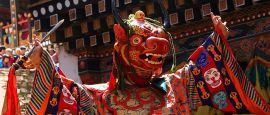Bhutan Weather, climate and geography
Weather & climate
Bhutan's climate is incredibly diverse, influenced by altitude variations and the monsoon season. The country ranges from humid subtropical conditions in the southern lowlands to alpine weather in the high Himalayas. The best time to visit Bhutan largely depends on what you want to experience, but spring (March to May) and autumn (September to November) are the most popular seasons.
Spring (March – May)
Spring is one of the best times to visit Bhutan, with mild temperatures and lush landscapes. In the capital city, Thimphu, average temperatures range from 14.4°C (57.9°F) in March to 20°C (68°F) in April. This season is ideal for trekking and for witnessing the blooming of rhododendrons and other wildflowers, which paint the valleys in vibrant colours.
Summer/Monsoon (June – August)
The monsoon season brings heavy rainfall, especially in the southern regions, which receive between 3,000 to 5,000 mm (118 to 195 inches) of rainfall annually. Temperatures during this period range from 15°C (59°F) to 30°C (86°F), with high humidity levels. While the countryside is lush and green, the rains can cause landslides that may disrupt travel. However, this season sees fewer tourists, offering a peaceful and secluded travel experience.
Autumn (September – November)
With the monsoon rains retreating, autumn is ideal for trekking and sightseeing, offering clear skies, comfortable temperatures, and stunning Himalayan views. This is also when some of Bhutan's biggest festivals, including Thimphu Tshechu and Paro Tshechu, take place, drawing visitors from around the world. In Paro, average temperatures range from 23.4°C (74.1°F) in September to 13.9°C (57°F) in November. Autumn is another peak season, attracting hikers, culture lovers, and photographers alike.
Winter (December – February)
Winters in Bhutan can be quite cold, with snowfall in the higher regions. However, this is a great time to visit the lower valleys such as Punakha, Paro, and Thimphu, where visitors can enjoy crisp, clear days with minimal crowds. For example, in January, Punakha's average temperatures range from a high of 17°C (62.6°F) to a low of 4.3°C (39.7°F). Winter is also when black-necked cranes migrate to Phobjikha Valley, making it a fantastic time for birdwatching and off-season travel.
What you pack for Bhutan depends largely on the season and altitude of your travels. Layering is key, as temperatures can fluctuate significantly between day and night.
For spring (March–May) and autumn (September–November), lightweight, breathable clothing is ideal for daytime, but a warm jacket is necessary for cooler mornings and evenings, especially in the mountains.
During summer (June–August), monsoon rains are common, so a waterproof jacket, quick-drying clothes, and sturdy shoes are recommended. In the southern regions, where it remains warm and humid, light cotton clothing is most comfortable.
Winter (December–February) can be cold, especially in higher altitudes, so thermal layers, thick jackets, gloves, and scarves are essential if visiting places like Bumthang or Haa Valley. However, in lower valleys like Punakha, winter temperatures remain mild, requiring only a light jacket.
Regardless of the season, both male and female visitors should dress modestly, especially when visiting religious sites—shoulders and knees should be covered. Comfortable walking shoes are a must for Bhutan's uneven terrain and frequent temple visits.
Do you have any Feedback about this page?
© Columbus Travel Media Ltd. All rights reserved. No part of this site may be reproduced without our written permission, click here for information on Columbus Content Solutions.
¿Tiene comentarios sobre esta página?
© Columbus Travel Media Ltd. All rights reserved. Ninguno de los contenidos de esta Web debe ser reproducido sin nuestra autorización expresa y escrita. Para más información sobre como obtener permiso para la utilización del contenido clica aquí. No part of this site may be reproduced without our written permission, click here for information on Columbus Content Solutions .
Avez-vous des commentairessur cette page?
© Columbus Travel Media Ltd. All rights reserved. Le contenu de ce site ne peut être reproduit sans autorisation écrite. Cliquez ici pour plus d'information sur notre 'des solutions de contenu’. No part of this site may be reproduced without our written permission, click here for information on Columbus Content Solutions.
Haben Sie Feedback zu dieser Seite?
© Columbus Travel Media Ltd. All rights reserved. Alle Inhalte dieser Seite sind urheberrechtlich geschützt und dürfen nur mit schriftlicher Genehmigung des Verlags genutzt werden. Weitere Informationen finden Sie in unseren Lizenzbestimmungen. No part of this site may be reproduced without our written permission, click here for information on Columbus Content Solutions .





 You know where
You know where